
How smart cities are reshaping urban life in 2025
Discover the key drivers of positive smart city development, including collaboration, data literacy, and a sharp focus on sustainability.


A brain-computer interface (BCIs) is a communication link between the electrical activity in the brain, and a computational device that serves a function for the user. BCIs can be split into two key categories:
We ask Dr. Ramses Alcaide (President and CEO at Neurable) to explain the difference; and then explore the healthcare applications of passive use BCIs.
“One way non-invasive BCIs can be used actively is by allowing individuals to control devices or perform actions using their thoughts,” Alcaide said.
“For instance, someone could use a BCI to move a cursor on a screen, type on a virtual keyboard, or even control a robotic arm. This is particularly valuable for individuals with mobility impairments, as BCIs offer a means to interact with the world without relying on traditional physical interfaces.”
To leverage an active use BCI, the user has to know what they want the interface to do – so they can get it to do that thing. Passive use BCIs, however, operate more independently; they can monitor and respond to brain activity without any conscious input from the user.
“Passive use of BCIs involves monitoring brain activity without necessarily requiring the user to perform specific actions,” Alcaide explained. “This can be applied in various contexts such as mental state monitoring or cognitive assessment.”
“For example, a non-invasive BCI could be used to detect signs of mental fatigue, stress, or attention levels. In gaming, it might adapt the game difficulty based on the player's level of engagement.”
The impact of active use BCIs on healthcare are more obvious: we see them in action, with the use of prosthetic limbs and brain-controlled communication devices, for example.
But passive use BCIs that monitor the cognitive and mental states of patients have less obvious – but equally revolutionary – implications for healthcare.
They could enable:
The bottom line is that advancements in BCI technology have real potential to improve patient outcomes – and make lives better.
Alcaide said:
“In essence, non-invasive BCIs open up new possibilities for human-computer interaction by tapping into the incredible capabilities of the brain. They have the potential to enhance accessibility, improve quality of life for individuals with disabilities, and offer novel ways to interact with technology in both active and passive capacities.”
Research in this field continues to progress, with new applications emerging regularly. We’ll explore the latest developments in BCI technology at LEAP 2025 – connecting tech innovators with healthcare pioneers to enable new frontiers in healthcare.

Discover the key drivers of positive smart city development, including collaboration, data literacy, and a sharp focus on sustainability.

Some of the most experienced tech investors in the world share their insights and advice to help new investors on their path to success.

Discover how brain-computer interfaces (BCIs) are creating new possibilities in healthcare and medicine.

Discover the key drivers of positive smart city development, including collaboration, data literacy, and a sharp focus on sustainability.

Some of the most experienced tech investors in the world share their insights and advice to help new investors on their path to success.

Discover how brain-computer interfaces (BCIs) are creating new possibilities in healthcare and medicine.